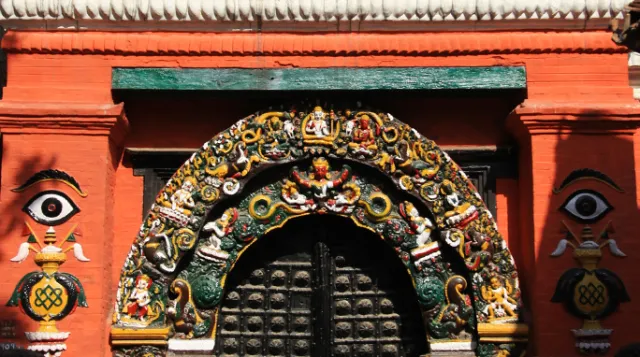Share this Article
Introduction
Nestled within the winding streets of Kathmandu, Bhaktapur, and Patan, Nepali temples (dyo chhen – temple houses) tell stories that go beyond devotion and ritual. Their ornate wooden doors, often overlooked by hurried tourists, are repositories of history, spirituality, and artistry. Every carved panel, every delicate motif, and every carved deity is a silent storyteller. These doors are not merely entryways; they are thresholds to the divine, canvases of faith, and protective guardians in wood and metal. The moment one stands before a temple door, one is invited to witness centuries of craftsmanship, belief, and sacred geometry interwoven into timber.
In Nepal, the tradition of carving temple doors goes back to the Licchavi era (4th–9th century), but it was the Newar artisans of the Kathmandu Valley who perfected it into a mesmerizing art form. The doors are more than architectural embellishments; they embody cosmic principles, mythological narratives, and local folklore. From the fierce Bhairav guarding entrances to delicate lotus motifs symbolizing purity, every element conveys profound meaning. To walk through a Nepali temple door (dyo dhoka) is to cross from the earthly world into a sacred space, leaving behind mundane concerns and stepping into a realm of devotion and reflection.
The Sacred Threshold: Between Human and Divine
In traditional Nepali architecture, the door is a symbolic boundary. It separates the human realm from the divine, the profane from the sacred. Stepping over the threshold of a temple door requires humility, often physically enacted by bowing slightly, as seen in temples like Taleju Bhawani in Kathmandu Durbar Square. The low height of the door forces visitors to bend, signaling respect and reverence.
The door itself (dyo dhoka) is treated as a guardian. It is believed that the carvings imbue protective energies that filter out negative thoughts and ill intentions. In many temples, these thresholds are aligned according to Vastu Shastra principles, ensuring cosmic harmony. In essence, the temple door is both literal and metaphysical, functioning as a spiritual filter, a boundary that separates daily life from sacred rituals.
Origins of Woodcarving in Nepal
Woodcarving in Nepal has ancient roots. During the Licchavi period, temples and palaces began incorporating wooden elements with intricate designs. However, it was under the Malla kings that Newar artisans elevated woodcarving to an unparalleled art form. Their works combined aesthetic mastery with spiritual symbolism. Timber, abundant in the Himalayan foothills, became a medium not only for architecture but for storytelling.
Nepali temple doors often feature three layers of meaning. The first layer is protective, often manifesting as fierce guardian deities (dewal – gods) and lions (singha). The second layer is educational, narrating mythological tales from the Ramayana, Mahabharata, and local folk stories. The third layer is spiritual, embedding symbols of cosmic order, enlightenment, and divine presence.
The Newar Artisans: Custodians of the Sacred Craft
The Newars, indigenous inhabitants of the Kathmandu Valley, are the custodians of this exquisite craftsmanship. Known as Shilpakar (artisans), they train for decades to master both design and symbolism. The creation of a temple door is not merely technical; it is ritualistic. Before touching the wood, artisans often pray to Ganesh, the remover of obstacles, seeking inspiration and divine guidance.
Each artisan learns to read and interpret traditional iconography. Carvings of deities, mythical animals, floral patterns, and geometric motifs are chosen not just for aesthetic appeal but for their symbolic resonance. This deep understanding ensures that every temple door serves multiple purposes: protection, education, and spiritual elevation.
The Spiritual Purpose of Temple Doors (Dyo Dhoka)
A temple door is a spiritual interface. Its carvings act as visual mantras, each motif reciting stories of faith and morality. The doors of Changu Narayan, one of Nepal’s oldest temples, exemplify this principle. Its intricately carved wooden panels narrate tales of Vishnu’s avatars, mythological battles, and local legends, allowing devotees to engage with the divine before even entering the sanctum.
The door’s function extends beyond symbolism; it is also a protective barrier. Historically, these wooden doors were fortified to prevent desecration during invasions. The carvings, however, imbued the doors with a metaphysical shield, believed to repel evil spirits and negative energies. In this way, the temple door serves a dual purpose — physical and spiritual protection.
Guardians of the Threshold – Gods, Lions, and Serpents
Nepali temple doors are rarely silent. They are adorned with guardian figures meant to ward off evil. Bhairav, a fierce form of Shiva, is often carved at entrances to instill awe and respect. Lions (singha) are symbolic protectors, representing strength and vigilance. Serpents (naga) wind along door frames, symbolizing cosmic energy, fertility, and eternal cycles of life.
Even smaller decorative motifs have protective intent. Floral garlands, geometric mandalas, and auspicious symbols like swastika or vajra are carved with precision. In tantric philosophy, the placement of these symbols aligns with energy channels, ensuring the temple remains a harmonized sacred space.
The Dance of Geometry and Nature
Geometric patterns, floral motifs, and mandalas are not mere decoration; they encode profound cosmological truths. The lotus, frequently carved along door panels, symbolizes purity and spiritual awakening. Mandala patterns represent the universe in its idealized, circular form, reminding devotees of the cycles of life, death, and rebirth.
Nature itself is revered in Nepali temple doors. Birds, mythical animals, and trees intertwine in carvings, reflecting a worldview that celebrates harmony between humans, nature, and the divine. In many temples, even the smallest carvings echo this philosophy, making the door a microcosm of the universe.
Myths Carved in Timber – Storytelling Through Symbols
In Newar tradition, temple doors function as visual scripture. Stories from the Ramayana, Mahabharata, and local legends are depicted across panels. In Patan Durbar Square, for instance, temple doors tell tales of local gods like Rato Machhindranath and Seto Machhindranath, blending folklore with moral lessons.
These carvings served educational purposes in times when literacy was limited. Devotees could learn ethical teachings and divine stories by simply observing the doors. Each panel became a visual sermon, blending art, culture, and spirituality.
Colors, Metals, and Sacred Ornamentation
Originally, many doors were painted with bright pigments or adorned with gold leaf. Red symbolized divine energy and protection, while gold reflected enlightenment and the eternal light of the gods. Metal studs and rings were not just decorative; their placement often followed numerological and tantric principles, enhancing the door’s protective and spiritual functions.
Some temple doors incorporated hanging bells, which would ring as devotees entered, signifying the start of a spiritual experience. The sound itself was considered purifying, scattering negative energies before the devotee reached the sanctum.
Philosophy of the Wood – From Tree to Temple
The selection of timber itself carries symbolic weight. Sal (Shorea robusta), Chilaune (Schima wallichii), and Teak were preferred for their durability, resilience, and sacred associations. Trees were often ritually felled with prayers, acknowledging the life being transformed into a medium of devotion. The wood was believed to retain spiritual energy, making the finished door a living presence of divine protection.
Rituals of Craftsmanship – The Spiritual Discipline of the Shilpakar
The act of carving was as sacred as the door itself. Artisans, or Shilpakars, approached the task with meditative focus. Prayers, mantras, and offerings were performed before chisels met wood. Each carving stroke was deliberate, embodying devotion and intention. This ritualized approach ensured that the door was not merely art but a conduit for divine energy, blessing every devotee who approached.
The Temple Door in Daily Life – Between Faith and Function
Beyond their spiritual role, temple doors were practical. They regulated entry, preserved sacred rituals, and even served as community notice boards in some villages. In Newar towns, announcements, rituals, and local festivals often centered around the temple threshold, highlighting the door’s role as both a physical and social connector.
Preservation and Decline in the Modern Age
Urbanization, pollution, and neglect have threatened these masterpieces. Many wooden doors have decayed or been stolen, ending up in private collections abroad. Traditional techniques risk being lost as younger generations migrate from artisanal villages to cities. Without proper preservation, centuries of spiritual and artistic knowledge could vanish.
Revival of the Ancient Craft – The New Wave of Nepali Artisans
Fortunately, efforts are underway to revive this heritage. Organizations in Bhaktapur, Patan, and Kathmandu train new generations of artisans in traditional woodcarving, using both classic techniques and modern documentation methods. Contemporary temples and cultural centers increasingly commission traditional doors, blending historical authenticity with modern functionality. This revival ensures that the sacred dialogue between craftsmanship and devotion continues.
Conclusion – The Door as a Living Prayer
The wooden doors of Nepali temples are living testimonies of faith, culture, and art. Every carving, every symbol, and every panel conveys lessons in devotion, protection, and cosmic harmony. They are thresholds of reverence, storytellers of myth, and guardians of sacred space. To stand before a Nepali temple door is to witness a dialogue that spans centuries — a conversation between artisan, devotee, and divine. These doors are not merely entryways; they are living prayers carved in wood, inviting every visitor to pause, reflect, and enter with a humbled heart.
Nepal’s temple doors remind us that art and spirituality are inseparable. Through wood and devotion, they teach lessons that are timeless, echoing the soul of a nation where every carving is both history and hope, protection and poetry, earthly craftsmanship, and celestial inspiration.
Categories:
Culture & Traditions
Tags:
ArchitecturalArt
,
SacredArchitecture
,
NepalPhotography







